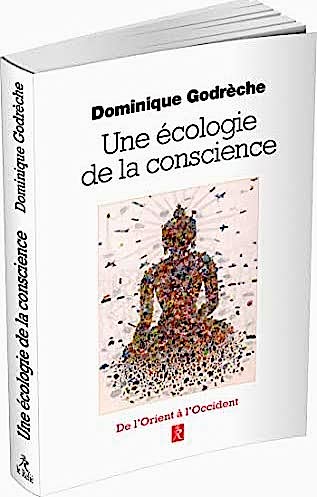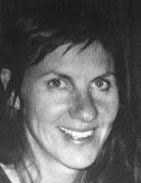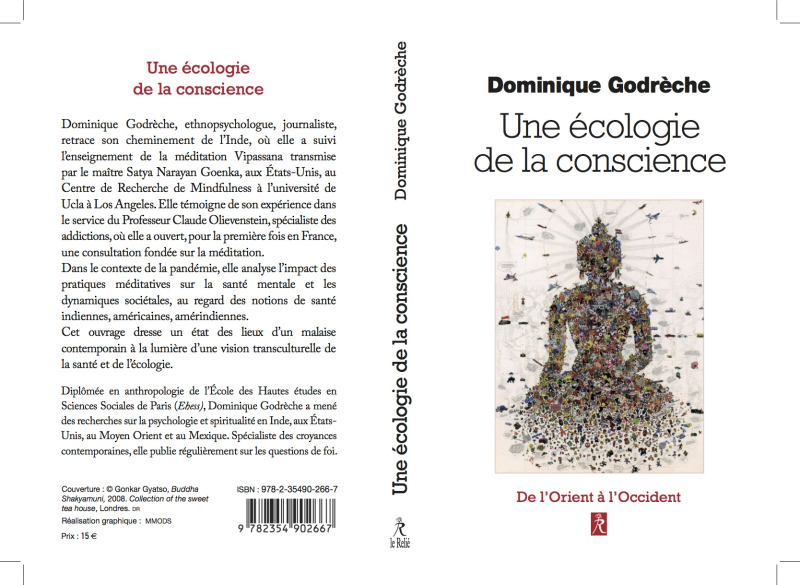
UNE ÉCOLOGIE DE LA CONSCIENCE
DOMINIQUE GODRÈCHE
In her new book, An Ecologie of Consciousness, French author Dominique Godrèche bridges cultures to explore the impact of meditative practices on mental health and society in a time of pandemic.
a Paris Writers News Interview
_______
PWN: What is Une Ecologie de la Conscience about?
Dominique Godrèche: The book is a philosophical, anthropological, existential road trip from India to Europe and the United States. A transcultural vision of contemporary societal, ecological issues about psychology, spirituality, with a global perspective. It starts in India, where I followed the Buddhist Vipassana meditation sessions with the Indian master Satya Narayan Goenka, then proceeds to Paris, where I opened the first consultation in France based on meditation, in the department for addictions of Professor Claude Olievenstein, during its experimental phase. It continues in the United States, at the Marc department of UCLA University (the mindfulness research department) where I researched on the use of mindfulness in an institutional context, and the adaptation of eastern philosophical practices to western societies. It relates to Native American culture, while at SAR in New Mexico, the School of American Research of Santa Fe, ( now School of Advanced Research) as an associate researcher during my PhD of anthropology. It describes how different cultures envision health in a broad perspective: individual, collective, societal.
What is mindfulness and why is it important?
Mindfulness is the adaptation of ancestral Buddhist meditation to western societies. It was introduced in the United states by doctor Kabat Zinn, who told me during our interview (for Buddha News), “meditation is a way to free oneself from suffering. I looked for a way to introduce this practice without identifying it as Buddhist, because the majority of people do not wish to become Buddhist. So I taught the essence of Dharma without the Buddha dharma, in order to transmit it without the Buddhist connotation.»
Mindfulness is important as it became a way of life today, because it provides peace, serenity, develops the attention, awareness of the present moment. And ultimately prevents violence, through non violent communication. It has replaced the teachings of Buddhist or Hindu meditation, as a secular modern tool to access inner calm and peace of mind, a non medical way to heal anxiety, without the consumption of pills. Because of its multiple usages, it has been adapted to multiple professional contexts –for therapy, but also business…As it helps focusing, and allows to become more efficient, by developing a better quality of attention.
Thus its success and expansion. Also, it is accessible, because it does not imply a religious or spiritual adhesion, and proposed as a simple mental exercise. I have been able to observe that in Los Angeles, in the huge amphitheater of UCLA: hundreds of people were receiving an initiation given by the Marc team in order to access a quick state of relaxation. That is what my book addresses: how sophisticated long term teachings from eastern cultures have been reduced to simple exercises, with no cultural background or philosophical connotation attached. The psychiatrist Dan Siegel, from UCLA, was telling me, “it is just a way of training a muscle”. And Robert Thurman, “Buddha was the first scientist; because Buddhism is a science. Thoughts are a driving force, so we must train our minds. It is neither religious, or dogmatic. But scientific”. A pragmatic approach developed in the United States; so much part of the life style that “mindfulness eating sessions” are advertised.
And with today’s technological addictions, the over use of iPhones and social networks, -Tik tok, Instagram- etc. we have entered a new era of virtual reality, time, and space: the meaning of time changed drastically with the intensive use of technology, a shelter for loneliness. It has replaced live communication, modified usual perceptions. So much that applications have set up time-limit reminders to avoid over usage, and maintain people in a “regular” time frame. In this context, mindfulness is a precious tool as a reminder of real time, versus “elastic” virtual time and spaces. And the “here and now” concept became a mental health help.
You've studied the culture and art of Indians of the American southwest for many years. Did this influence this book?
It did; the title, “an ecology of consciousness”, refers to environmental ecology, as much as personal, mental, emotional ecology. Those notions, inherent to Native American culture are reflected in the “Navajo way of beauty”, and its prayer “walking in beauty “ :
“In beauty I walk, with beauty before me I walk, with beauty behind me I walk, with beauty above me I walk, with beauty around me I walk…Today I will walk out, today everything negative will leave me. I will have a light body, nothing will hinder me. beauty all around me may I walk.”
This approach is illustrated in the Navajo sand painting, which addresses the way the body, the mind, and the universe are interrelated. A holistic concept based on harmony and balance: in the Navajo sand painting, the patient’s body is in contact with a painting drawn on the earth.
Harry Walters, a Navajo anthropologist, explains, “Hozho, the Navajo word, describes peace, harmony, balance. The word beauty is related to healing and balance, not to art, a word that does not exist in Navajo; when we say beauty, we mean religion, philosophy, health. For us, everything is related.”
I was able to observe this correlation between health and the earth in New Mexico, at the Santuario de Chimayo, a healing place where I was brought by Imogene, a Native American friend. There, I watched the people in search of a relief, a cure, applying the Santuario “healing” dirt on their arms, their legs...A special atmosphere; an experiential situation, where human needs, the earth, and faith meet in a church. This perception of the earth as a healing factor is shared by various Native cultures.
Native American art commonly relates to the concept of Mother Earth, the notion of harmony and balance between the human existence and the land, its health. It addresses the concepts of “life ways”, its philosophy. I felt this power of the land in New Mexico, its physical, mental, spiritual impact. And when I was told my feelings to Godfrey Reggio, -the Santa Fean film maker of the series “Qatsi”, ( the Hopi concept of balance)-, he answered, “it is because the earth here has a special power, and gives you strength. It is a source of energy”.
Do you have a personal meditation practice? If so, how did you get started?
I left for India at the age of 17, having studied Indian philosophy, music, and art. I was a great fan of the filmmaker Satyajit Ray, and discovered India through his films. And had the chance to meet him at his home in Calcutta, on my way to Rabindranath Tagore Art School, Shanti Niketan, that he had also attended. Over the years I traveled all over India, looking for spiritual ways and teachings, including yoga with Geeta, the daughter of B. K. S. Iyengar. During my travels, I met fascinating people: the niece of Aldous Huxley, Olivia, in Dharamsala, the American-Russian princess Zina Rachevsky. Both had become Buddhist nuns, and I stayed with Zina, at the Kopan monastery she had founded. I visited various ashrams, from the most utopian
–in Pondicherry (Sri Aurobindo)-, with its city Auroville, to the most traditional, like the one in Tiruvannamalai, where I walked the sacred mountain…I encountered incredible meditators, secluded since decades in the mountains of Rishikesh...Then a friend suggested I join Goenka’s sessions, though he did not know where to find them, as they were itinerant, with no headquarters, like today.
So I started to search for Goenka. His teachings took place in a different location every ten days, and he traveled constantly. But one day, in an airport near Bombay, I was chatting with a gentleman while waiting for my luggage: he asked me the reason of my visit to India. I told him I was looking for Goenka, he smiled, and answered, “I am Goenka ». This is how I attended my first Vipassana session with him soon after; I was 19. I describe this experience in the chapter
«Carnets de Vipassana», a diary of the session explaining the various techniques of meditation.
How did you research this book?
The book covers three periods and places: the first one in India, «Santana, a Vipassana diary”. The second, “Return to France, encounter with professor Claude Olievenstein». The third one in the United States, “mindfulness, a north American invention”, at UCLA, an analysis of the north American approach of Oriental meditative practices, and their adaptation to the American culture. It also refers to my research in Santa Fe, at the Navajo psychiatric department, among other internships. I published a comparative approach of French and American psychotherapy, an analysis of memory and time in the therapeutic process of both cultures, and among bicultural populations (Native American, Hispanic American). So the research covers Buddhist philosophy, American anthropology, French and American clinical psychology.
Why this book now? Did the pandemic play a role?
Indeed. The book started during the pandemic: my publisher wanted to launch a new edition of Santana (Albin Michel). And I had noticed how the techniques of self control, calm… were advertised online during that period in order to fight the anxiety of the lock down. Also the way the pandemic was reactivating, a “no future” atmosphere, a grim future, lacking dynamics, an absence of projections, addressing the difficulty of living in closed spaces, etc.…in that context, meditation, or philosophical practices, were advertised like well being techniques, gymnastic, with no philosophical connotations attached, but predominantly the sale of sport accessories, - clothes-, etc.…A very materialistic approach of ancestral spiritual technics transformed into commodities. So I decided to write a new book related to the time of the pandemic, and included Santana the Vipassana diary, with a philosophical vision of the lock down, and its impact on our minds in that situation of closure, since we were not allowed to go out, except one hour a day.
It addresses the transformation of spirituality in today’s era in the West. Stuck in the house, I wrote the first part of the book, linking the confinement of the pandemic to the philosophical confinement during a Vipassana session, where we could not go out for 10 days, and introduced my research in New Mexico, and UCLA. The book ends after the confinement, in the south of France, in “Beauty”. It follows different phases: total confinement, philosophical confinement, liberation. It addresses the issues of closure, health, the capacity to stay locked at home, and in ourselves. It questions the issues of inner and outer space, and how they interrelate in different cultures -Asian, European, American-. It ends during the post confinement, with the rediscovery of freedom, -like after a Vipassana session-, when we go back to «normal life», and nature…with a feeling of wonder. So it really followed the process of the confinement. The pandemic has opened new doors of consciousness: about health, our resilience, the relation between ourselves and the environment, survival in today’s world... emphasizing our relationship to the environment. To quote Allen Ginsberg, “Earth pollution identical with mind pollution, consciousness pollution identical with filthy sky”. Goenka used to say that meditation was a way of “cleaning one‘s mind”: an ecology of consciousness.
Who did you write 'Une Ecologie de la conscience' for? What are you hoping your readers get out of it?
Une écologie de la conscience is written for a wide category of readers, as it addresses philosophical, psychological, environmental, existential, spiritual issues, on a global scale; in India, in Europe, the United States…it is a story about a personal experience, but beyond: it questions collective contemporary anxieties and life-balance, to which everyone can relate. I see the book as a tool to reflect on health in a holistic sense: mental, emotional, societal…And the relation to the environment, the memory, the status of philosophical practices in the modern globalized world. How to deal with pain, dependency, post traumas, inter cultural relations, identity, time and space…It is conceived as a platform to engage into a debate on various topics, a starting point to address multiple aspects of our lives, -contemplative, or active-. It questions the way we inhabit this world, our ability to cope with extreme, or difficult situations. And how specific practices can lead to a harmonious state of consciousness; to ultimately create, -if not ”a better world”-, a better quality of life, and communication, on a day to day basis.
It also addresses a transcultural approach of health and consciousness, through the eyes of Native cultures, in Mexico, and New Mexico, related to my encounters with traditional medicine people, whose practices are intimately associated to the consciousness of nature and its role in our life balance. And how different times, places and cultures meet on this matter.
Is writing a form of meditation? What is your writing practice like?
Writing catalyzes a state of mental absorption. Not “meditation” per se, as meditation consists in emptying one’s mind from any thought. And writing requires a lot of thinking…But the process of mental absorption creates a state of concentration close to meditation, because of the focus needed; and in fine, puts you in a state of deep mental absorption. I write every day; stories for medias, a diary. Notes while walking, mentally; when in a cafe, or a garden, I imagine a story: watching someone, ideas come to my mind about life situations…Writing does not start when I physically write. I might want to write a story about someone by looking at the person talk, walk, or move, by the way she interacts with the space. The environment and the space I find my self in have a lot to do with my writing process and inspiration: in Venice, I constantly have ideas when walking, looking at the houses, the architecture, a square, a “campo”…the people gathering, the sounds of the canals. The space -geographical, architectural, with its sounds…is inspiring. The way people move in this space -narrow streets, endless bridges, small squares, gardens-… Creates a variety of silent and musical environments.
Which artists or writers inspire you?
J.M.G le Clezio, Antonin Artaud, André Breton, Paul Eluard, Marguerite Duras, René Guenon, Michel de Certeau, Vladimir Jankélévitch. Jorge Luis Borges, Octavio Paz, J. D Salinger, Henri Miller, Lawrence Durrell, Primo Levi, Fyodor Dostoievski... The artists Rothko, Yves Klein, Marc Chagall, Pablo Picasso, Anish Kapoor, sculptor George Jean Clos. Native American sculptors Roxanne Swentzell and Craig Goseyiun in New Mexico; conceptual artist Charlene Teters. Violinist Yehudi Menuhin, composer Philip Glass. Movie actor Benicio del Toro, whom I interviewed; film makers Carl Dreyer, Wim Wenders, Godfrey Reggio… And many others !
What books are you reading?
La maladie de la mort by Marguerite Duras, l’Extase matérielle by Le Clezio, Arcane 17 by André Breton, les Tarahumaras by Antonin Artaud, la Prise de Parole by Michel de Certeau, le Non Lieu by Marc Augé.
What are you working on now?
The Jerusalem Syndrome, a religious pathology I studied in Jerusalem with psychiatric, religious, and cultural experts, on which I published articles in Paris Match, Ca m’interesse, le Point among others. It questions the status of religion and faith nowadays, and the impact of religious architecture and sacred geography on the psyche. The book project addresses art, esthetics, history, beliefs, psychology, anthropology, and politics.
Une écologie de la conscience is related to faith and spiritual anxiety in the 70’, 80’, when people were searching for a new life style, in that societal, political era, of a “peace and love” trend originated in the united states, with a large adhesion to oriental disciplines, and the later creation of counter culture communities based on extra European philosophy (mostly Asian). In India, most of the westerners I met were Americans; I met the same groups later in the united states, in communities like the Naropa Institute in Boulder. “An ecology of consciousness” addresses this quest for non violence, for a peaceful mind, and the encounter between Asia and the United States.
This new project analyzes blind, desperate “faith”, the need to believe at any cost and how it can lead to addictive scenarios of violence. It takes place between Jerusalem and the West, addressing transcultural and interfaith interactions, and the role of the “here and now“ concept: real time, real space, versus an imaginary one. It questions life between fiction or reality, how one wins over the other, and the consequences. Ultimately, it interrogates the sense of identity: what does “being one self” mean in today’s society, and the choices people make to create their identity.
 About the author
About the author
Dominique Godrèche is a writer, ethno psychologist, graduated from EHESS Paris, Ecole des Hautes Etudes en Sciences Sociales de Paris, specialized in issues related to identity, art, faith and beliefs, in the Middle East, United States, Mexico, Europe. Awardee of Le Prix de la Villa Medicis hors les murs in Literature for her essays on contemporary Native American culture, she was the correspondent of Indian Country Today magazine for Europe, and is a contributor to French medias, including Libération, Paris Match, le Point, Le Monde Diplomatique, and We Demain.
***

émissions de radio/Radio
https://frequenceprotestante.com/events/pour-une-ecologie-de-la-conscience/ "ET MAINTENANT LA GRANDE TRANSITION" FREQUENCE PROTESTANTE
https://www.airzen.fr/dominique-godreche-pour-une-ecologie-de-la-conscience/ "L'INSTANT PRÉSENT" AIR ZEN RADIO
Une Ecologie de la Conscience
Publisher: TREDANIEL
Language: French
Pages: 223
Available at bookstores and online
FNAC
DECITRE
AMAZON
